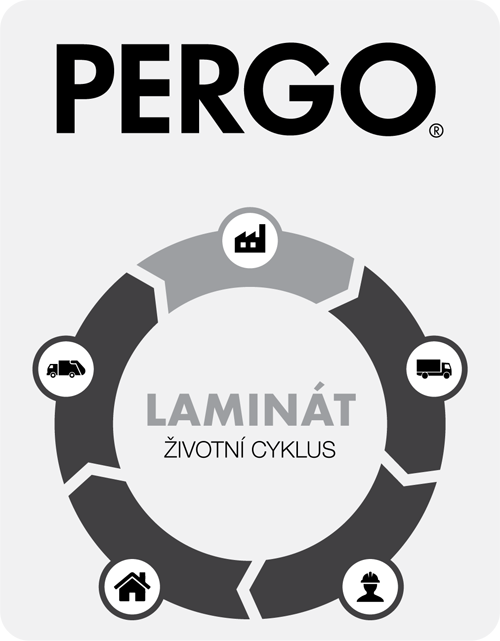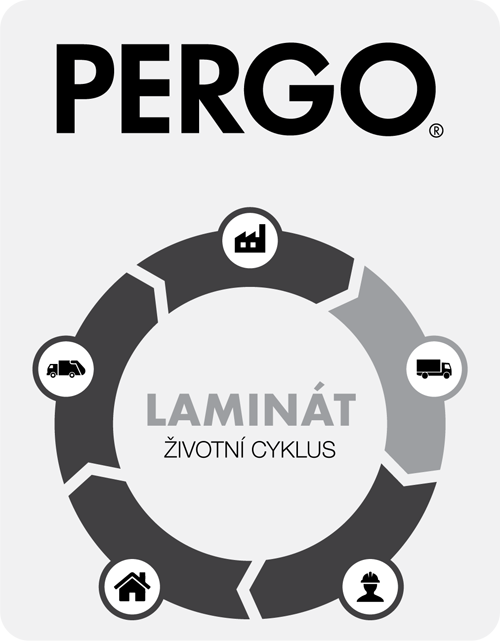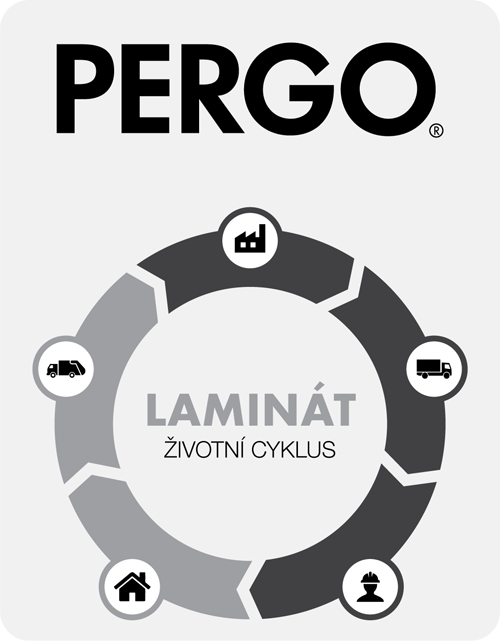
Laminat Pergo – a story about sustainability
Engagement for Nature: Unilin recognizes that the world you want to live in is not just about stylish interiors. It is also a world that radiates respect for the natural environment. That is why we constantly strive to maintain a minimal impact of our products and processes on the environment.
Our principles:
We realize that the world in which you would like to live is not just made up of stylish interiors. It is also a world that shows respect for the natural environment. This is why, as a company, we continuously strive to minimize the ecological impact of our products and processes. Every day we seek new ways to recycle, reduce waste, and renew materials throughout the entire laminate manufacturing process. That is why we have compiled a product life cycle overview to allow you to understand our efforts in developing sustainable products more deeply and to show how we adhere to the aforementioned principles.
By sustainability, we mean responsible resource sourcing. One aspect of such sourcing is the effort to utilize energy from renewable sources while also striving for energy efficiency. However, when we look at sustainability more broadly, we see other aspects for which we are responsible.
Raw Materials
To produce laminate, high-density fiberboards (HDF) are needed. These are made from softwood fibers that are broken down, mixed with wax and a resin binder, and then shaped into panels using heat and pressure. Our company differs from competitors mainly by manufacturing our own HDF boards to control the entire process related to the raw materials used in their production. As a result, we produce fiberboards from 100% recycled wood. During wood processing, by-products from small and crooked trees and residual waste from other sectors are generated. This ensures a constant supply of quality, sustainably sourced fiberboards. That is why our products carry a certificate that represents the only reliable label for customers and confirms that wood flows within the company are fully monitored and controlled for sustainability.
Energy Sources for the Business
Like most manufacturing processes, the production of laminate panels requires energy. Unilin extensively invests in technologies that enhance energy efficiency, significantly reducing consumption and increasing the share of "green" energy.
By implementing an internal biomass power plant, we produce green electricity and can therefore manufacture laminate in an environmentally friendly manner. Each year, we process more than 170,000 m³ of waste wood, from which raw material for panel production cannot be recovered, and which is thus converted into electricity for 51,000 households. All green energy that we do not use in our manufacturing operations is sold.
The biomass plant covers over 70% of the manufacturing facility's heat requirements and contributes to reducing CO2 emissions by 25,000 tons annually.
We are also looking for more energy-efficient production methods, and thanks to this effort, we have developed a process for laminating various layers of laminate that requires much less energy than traditional lamination technologies. We have implemented a modern UV curing system, using environmentally friendly ultraviolet light instead of energy-intensive hot air ovens for curing the surface layer, thus minimizing heat requirements.
Water Supply and Waste Management
The water used in operations is primarily intended for heating and cooling during production. Water management and the protection of water sources are among the main pillars of environmental protection worldwide. Unilin recognizes this fact and has therefore taken several measures to reduce water consumption during production and prevent wastewater generation. We can confidently state that 97% of the supplied water intended for production comes from internally recycled water. Additionally, +1,000 m³ of rainwater is reused.
We strive not only to avoid wastewater generation but also to eliminate waste creation at workplaces by optimizing the recycling process, in which 100% of the production waste is recycled. We guarantee that no waste leaves our manufacturing facility for landfills.
Packaging
Green, environmentally friendly product transportation begins with packaging the product. The entire laminate packaging is made of recyclable material. Since the packaging is 100% recyclable, it is certified with the FSC label. The acronym FSC stands for the non-profit organization Forest Stewardship Council, which aims to achieve globally sustainable forestry practices. Additionally, the pallets used for transporting laminate for easy shipping can also be reused 100%.
Distribution Network
Our global network of warehouses allows us to shorten supply lines to supply local markets. With warehouses and distribution centers in Belgium, the UK, Sweden, France, Poland, Ukraine, Russia, and the USA, we can combine product transportation and avoid poorly optimized transport. This has led us to reduce and monitor our ecological footprint.
Alternative Transport Methods
Trucks represent a carbon-intensive mode of transport, and therefore, we want to increase sea deliveries of 3 million m² of laminate flooring per year by up to 50% in addition to road transport. For this reason, we have created a transport corridor through the Wielsbeke river terminal to the ports of Antwerp (Belgium) and Malmö (Sweden). For laminate deliveries to markets outside Belgium, we have also invested in intermodal freight transport, which uses two modes of freight transport: road and rail. Alternatively, we use short sea routes for deliveries to Scandinavia and Russia with the help of coastal cargo ships.
Installation of Laminate
Installing laminate is very quick and easy. Our products do not need prior preparation - they are ready for immediate use. They can be easily cut with a jigsaw. No special tools are required. Unlike, for example, the installation of ceramic tiles, which creates a lot of mess and is costly and time-consuming, our laminate can be installed without hassle and with minimal waste.
Extremely Low VOC and No Harmful Substances
Choosing laminate is a choice for a healthy floor, as our products meet the strictest EU standards regarding the use of formaldehyde and emissions of volatile organic compounds (so-called VOCs). While competitors purchase resin binders from external suppliers, Unilin manufactures its own resin binder to control and monitor the correct dosing of individual components. As a result, we not only meet but exceed European standards, as we use resin containing 10 times less formaldehyde than set by the strictest EU standards. This also applies to the quantity of VOCs, which affects indoor air quality. Regarding volatile organic compounds, we have achieved producing laminate that releases 10 times less VOC than stipulated by the latest EU standards. Furthermore, our products do not contain carcinogenic, mutagenic, or reprotoxic substances of classes 1A and 1B (list of potential substances), nor harmful plasticizers.
Hygienic Advantages
One of the main characteristics that make our laminate flooring perfectly suited for high-traffic rooms and areas is the durable surface layer reinforced with aluminum oxide. The innovations used have also led to perfect sealing of the surface and joints, preventing damage from water and dirt. Bacteria will not have time to settle because they can be easily wiped away. Therefore, you do not need to use aggressive cleaning agents on laminate flooring.
At the end of its life, the waste flooring can be recycled into new (depending on local conditions). Information about local recycling programs in your area can be obtained from local retailers/ waste recycling facilities.
Our principles:
- We use thoroughly verified materials.
- We invest in energy-efficient production.
- We comply with (and not only that) all regulations.
 |
We realize that the world in which you would like to live is not just made up of stylish interiors. It is also a world that shows respect for the natural environment. This is why, as a company, we continuously strive to minimize the ecological impact of our products and processes. Every day we seek new ways to recycle, reduce waste, and renew materials throughout the entire laminate manufacturing process. That is why we have compiled a product life cycle overview to allow you to understand our efforts in developing sustainable products more deeply and to show how we adhere to the aforementioned principles.
Production of Laminate Flooring
 |
Raw Materials
To produce laminate, high-density fiberboards (HDF) are needed. These are made from softwood fibers that are broken down, mixed with wax and a resin binder, and then shaped into panels using heat and pressure. Our company differs from competitors mainly by manufacturing our own HDF boards to control the entire process related to the raw materials used in their production. As a result, we produce fiberboards from 100% recycled wood. During wood processing, by-products from small and crooked trees and residual waste from other sectors are generated. This ensures a constant supply of quality, sustainably sourced fiberboards. That is why our products carry a certificate that represents the only reliable label for customers and confirms that wood flows within the company are fully monitored and controlled for sustainability.
Energy Sources for the Business
Like most manufacturing processes, the production of laminate panels requires energy. Unilin extensively invests in technologies that enhance energy efficiency, significantly reducing consumption and increasing the share of "green" energy.
By implementing an internal biomass power plant, we produce green electricity and can therefore manufacture laminate in an environmentally friendly manner. Each year, we process more than 170,000 m³ of waste wood, from which raw material for panel production cannot be recovered, and which is thus converted into electricity for 51,000 households. All green energy that we do not use in our manufacturing operations is sold.
The biomass plant covers over 70% of the manufacturing facility's heat requirements and contributes to reducing CO2 emissions by 25,000 tons annually.
We are also looking for more energy-efficient production methods, and thanks to this effort, we have developed a process for laminating various layers of laminate that requires much less energy than traditional lamination technologies. We have implemented a modern UV curing system, using environmentally friendly ultraviolet light instead of energy-intensive hot air ovens for curing the surface layer, thus minimizing heat requirements.
Water Supply and Waste Management
The water used in operations is primarily intended for heating and cooling during production. Water management and the protection of water sources are among the main pillars of environmental protection worldwide. Unilin recognizes this fact and has therefore taken several measures to reduce water consumption during production and prevent wastewater generation. We can confidently state that 97% of the supplied water intended for production comes from internally recycled water. Additionally, +1,000 m³ of rainwater is reused.
We strive not only to avoid wastewater generation but also to eliminate waste creation at workplaces by optimizing the recycling process, in which 100% of the production waste is recycled. We guarantee that no waste leaves our manufacturing facility for landfills.
Delivery of the Flooring to the Customer
 |
Green, environmentally friendly product transportation begins with packaging the product. The entire laminate packaging is made of recyclable material. Since the packaging is 100% recyclable, it is certified with the FSC label. The acronym FSC stands for the non-profit organization Forest Stewardship Council, which aims to achieve globally sustainable forestry practices. Additionally, the pallets used for transporting laminate for easy shipping can also be reused 100%.
Distribution Network
Our global network of warehouses allows us to shorten supply lines to supply local markets. With warehouses and distribution centers in Belgium, the UK, Sweden, France, Poland, Ukraine, Russia, and the USA, we can combine product transportation and avoid poorly optimized transport. This has led us to reduce and monitor our ecological footprint.
Alternative Transport Methods
Trucks represent a carbon-intensive mode of transport, and therefore, we want to increase sea deliveries of 3 million m² of laminate flooring per year by up to 50% in addition to road transport. For this reason, we have created a transport corridor through the Wielsbeke river terminal to the ports of Antwerp (Belgium) and Malmö (Sweden). For laminate deliveries to markets outside Belgium, we have also invested in intermodal freight transport, which uses two modes of freight transport: road and rail. Alternatively, we use short sea routes for deliveries to Scandinavia and Russia with the help of coastal cargo ships.
Enjoy Laminate at Home
 |
Installing laminate is very quick and easy. Our products do not need prior preparation - they are ready for immediate use. They can be easily cut with a jigsaw. No special tools are required. Unlike, for example, the installation of ceramic tiles, which creates a lot of mess and is costly and time-consuming, our laminate can be installed without hassle and with minimal waste.
Extremely Low VOC and No Harmful Substances
Choosing laminate is a choice for a healthy floor, as our products meet the strictest EU standards regarding the use of formaldehyde and emissions of volatile organic compounds (so-called VOCs). While competitors purchase resin binders from external suppliers, Unilin manufactures its own resin binder to control and monitor the correct dosing of individual components. As a result, we not only meet but exceed European standards, as we use resin containing 10 times less formaldehyde than set by the strictest EU standards. This also applies to the quantity of VOCs, which affects indoor air quality. Regarding volatile organic compounds, we have achieved producing laminate that releases 10 times less VOC than stipulated by the latest EU standards. Furthermore, our products do not contain carcinogenic, mutagenic, or reprotoxic substances of classes 1A and 1B (list of potential substances), nor harmful plasticizers.
Hygienic Advantages
One of the main characteristics that make our laminate flooring perfectly suited for high-traffic rooms and areas is the durable surface layer reinforced with aluminum oxide. The innovations used have also led to perfect sealing of the surface and joints, preventing damage from water and dirt. Bacteria will not have time to settle because they can be easily wiped away. Therefore, you do not need to use aggressive cleaning agents on laminate flooring.
End of Floor Life
The user-friendly Uniclic/Multifit locking system allows not only hassle-free floor installation but also easy disassembly. This is especially interesting when you consider that the warranty on our category of laminate flooring can reach up to 33 years. Therefore, a homeowner can easily dismantle the floor and use it elsewhere.At the end of its life, the waste flooring can be recycled into new (depending on local conditions). Information about local recycling programs in your area can be obtained from local retailers/ waste recycling facilities.
 |
The English translation is powered by AI tool. Switch to Czech to view the original text source.
0 comments
add comment












